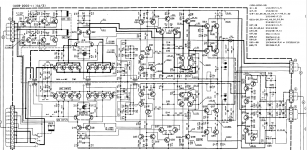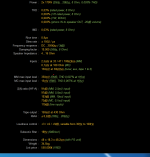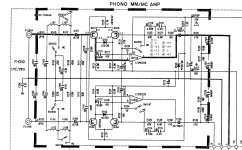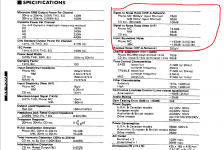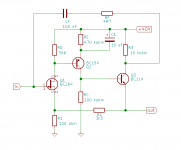probably shorted input so it misses the current noise component.
You can almost guarantee it. DIYaudio is about the only place where people measure phono stages in a sensible manner...and then overkill them a few more dB for good luck 🙂.
I think that Japanese companies followed the 300ohm JISA+FLAT and 2k2(20hz...30khz) Rs for RIAA noise standards .
You can almost guarantee it. DIYaudio is about the only place where people measure phono stages in a sensible manner...and then overkill them a few more dB for good luck 🙂.
Yes. I remember we took John Atkinson to task here for measuring phono stage noise by shorting the inputs.
Problem is he has many measurement reviews going back xpc. 25 yrs so it would be unfair to now start testing with a real world source.
@dreamth
That’s still not a nasty enough source! 1970’s phono stages were crap. Period.
Sorry to be blunt 🙂
It's late 70's early 80 actually.... and i can count at least 5 solid state phono preamps from that era that were better than anything else in that cathegory done in the next 30 years, both in noise and dynamic terms .
maybe you can point point out a better solid state design than this 1982 one....yeah, i know it has fet transistors too , but i also know a lot of other things i am not going to fill this topic with...@dreamth
That’s still not a nasty enough source! 1970’s phono stages were crap. Period.
Sorry to be blunt 🙂
Attachments
yamaha claimed some similar numbers, but in their specs there are two different standards so i can get a grasp on what 75 db means for some and what 75db means for others but in the end we all get is smth about 75db sS/R 🙂
https://ez.analog.com/audio/f/q-a/4073/ihf-a-network-vs-new-ihf-s-n-specs
https://ez.analog.com/audio/f/q-a/4073/ihf-a-network-vs-new-ihf-s-n-specs
Attachments
Last edited:
maybe you can point point out a better solid state design than this 1982 one....yeah, i know it has fet transistors too , but i also know a lot of other things i am not going to fill this topic with...
Indeed, it uses JFETs as the moving-magnet input stage. Anyway, the 1978 Hoeffelman and Meys circuit will probably outperform it, at least regarding noise.
yamaha claimed some similar numbers, but in their specs there are two different standards so i can get a grasp on what 75 db means for some and what 75db means for others but in the end we all get is smth about 75db sS/R 🙂
https://ez.analog.com/audio/f/q-a/4073/ihf-a-network-vs-new-ihf-s-n-specs
When it says "input shorted", you know it's nonsense.
If there's anything about intelectual rights, could you send that schematic to me too cause i couldn't find it with Google.I came on some documents signed by you but no schematic.Indeed, it uses JFETs as the moving-magnet input stage. Anyway, the 1978 Hoeffelman and Meys circuit will probably outperform it, at least regarding noise.
somehow the difference in yamaha between shorted and non shorted makes sense because the mc input noise rises by 1.5db while the mm input rises by 4 db from one measurement set to another.When it says "input shorted", you know it's nonsense.
Thank you! Anytime you can.Is that a current to voltage converter that inject current to the cartridge ?I'll have a look in the attic, but not right now.
Start with the cartridge and the load (47k // with c. 200pF for a 2 more cable).
That’s the absolute limit of performance and you cannot get better than that. So we can talk about IHF specs, blah blah blah but you can never be better than the Johnson noise of the source plus load.
Plug the data for your cart in here (Download the spread sheet) and set the opamp noise inputs to Zero
So Just How Quiet is Your Phono Stage?
That’s the absolute limit of performance and you cannot get better than that. So we can talk about IHF specs, blah blah blah but you can never be better than the Johnson noise of the source plus load.
Plug the data for your cart in here (Download the spread sheet) and set the opamp noise inputs to Zero
So Just How Quiet is Your Phono Stage?
Last edited:
yamaha claimed some similar numbers, but in their specs there are two different standards so i can get a grasp on what 75 db means for some and what 75db means for others but in the end we all get is smth about 75db sS/R 🙂
https://ez.analog.com/audio/f/q-a/4073/ihf-a-network-vs-new-ihf-s-n-specs
More nonsense from Yamaha - I don’t know how these manufacturers claimed this stuff.
The Yamaha circuit has a compromise input stage: the tail current is too low for moving coil and too high for moving magnet. As a result, its equivalent input noise voltage will dominate for moving coil and its equivalent input noise current for moving magnet. With shorted input, the equivalent input noise current has no effect, so you get reasonable numbers for moving coil and way too high numbers for moving magnet.
Last edited:
I didn't even bother to think of it...i found that example when trying to see what IHF-A means...The only numbers that i am really interested in when i see a new service manual are the input sensitivity and the max input overload margins...For kenwood are double than for yamaha as it's a discrete design supplyed at +-43v...In all the schematics i ever saw , the kenwood one is the best by far.Although it has such high supply rails it has soft clipping at every stage...and that's smart.The only thing that makes a phono preamp shine is his behavior under stress,not its out of this world SNR...
This is the original Hoeffelman and Meys configuration, redrawn to avoid copyright issues. It is just a flat-gain amplifier with a gain of 34 and an electrically cold 47 kohm input resistance. You can turn it into a RIAA amplifier by replacing R2 with a RIAA correction network. You need some kind of buffer after the output, as any load disturbs the input resistance. See the Journal of the Audio Engineering Society December 1978 (original article) and September 1979 (letter from Ernst Nordholt pointing out that R2 could be replaced with a RIAA correction network).
Attachments
- Status
- Not open for further replies.
- Home
- Source & Line
- Analogue Source
- FET vs BJT input phono preamp
